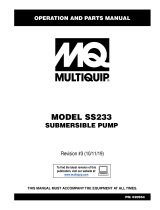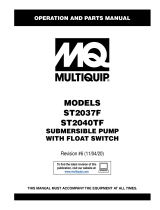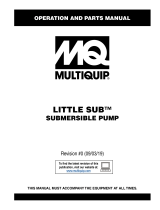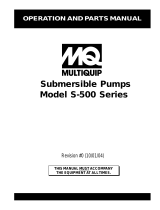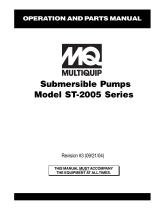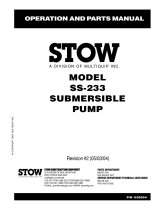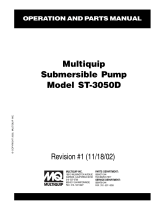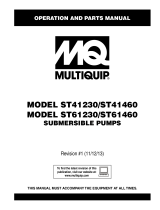Page is loading ...

OPERATION AND PARTS MANUAL
Revision #0 (10/04/04)
Submersible Pumps
Model ST-1500 Series
THIS MANUAL MUST ACCOMPANY
THE EQUIPMENT AT ALL TIMES.

PAGE 2 — ST-1500 SERIES SUBMERSIBLE PUMPS — OPERATION & PARTS MANUAL — REV. #0 (10/04/04)
© COPYRIGHT 2004, Multiquip INC.
Multiquip Inc, the MQ logo are registered trademarks of Multiquip Inc. and may not be used, reproduced, or altered without written
permission. All other trademarks are the property of their respective owners and used with permission.
This manual
MUST accompany the equipment at all times. This manual is considered a permanent part of the equipment and should
remain with the unit if resold.
The information and specifications included in this publication were in effect at the time of approval for printing. Illustrations are
based on the
MQ Model ST-1500 Series Submersible Pumps.
Illustrations, descriptions, references and technical data contained in
this manual are for guidance only and may not be considered as binding. Multiquip Inc. reserves the right to discontinue or change
specifications, design or the information published in this publication at any time without notice and without incurring any obligations.
To find the latest revision of this
publication, visit our website at:
www.multiquip.com
HERE'S HOW TO GET HELP
PLEASE HAVE THE MODEL AND SERIAL
NUMBER
ON-HAND
WHEN CALLING
MULTIQUIP CORPORATE OFFICE
18910 Wilmington Ave. 800-421-1244
Carson, CA 90746
FAX:
310-537-3927
Email: [email protected]
Internet: www.multiquip.com
PARTS DEPARTMENT
800-427-1244
FAX:
800-672-7877
310-537-3700
FAX:
310-637-3284
MAYCO PARTS
800-306-2926
FAX:
800-672-7877
310-537-3700
FAX:
310-637-3284
SERVICE DEPARTMENT
800-421-1244
FAX:
310-537-4259
310-537-3700
TECHNICAL ASSISTANCE
800-478-1244
FAX:
310-631-5032
WARRANTY DEPARTMENT
800-421-1244,
EXT.
279
FAX:
310-537-1173
310-537-3700,
EXT.
279

ST-1500 SERIES SUBMERSIBLE PUMPS — OPERATION & PARTS MANUAL — REV. #0 (10/04/04) — PAGE 3
ST-1500 SERIES SUB. PUMP — TABLE OF CONTENTS
Submersible Pump
Component Drawings
ST-1503A Pump Assembly ................................26-29
ST-1503CUL Assembly ......................................30-33
ST-1503A/CUL Electric Motor Assembly........... 34-35
Terms and Condition of Sale
— Parts .....................36
Multiquip ST-1500 Series
Submersible Pumps
Here's How To Get Help............................................ 2
Table Of Contents ..................................................... 3
Parts Ordering Procedures ....................................... 4
Safety Message Alert Symbols ................................. 5
Rules For Safe Operation ......................................6-7
Dimensions ............................................................... 8
Specifications (Pump/Control Box) ...........................9
General Information................................................10
Components............................................................11
Float Switches.........................................................12
Float Switch (Piggy-Back) .......................................13
Float Switch (Control Box) ......................................14
Operation ................................................................15
Control Box Installation ..................................... 16-17
Clean-up .................................................................18
Maintenance ...........................................................19
Troubleshooting (Pump)..........................................20
Performance Curves ...............................................21
Wiring Diagrams (Electric Motor/Control Box) ........22
Explanation Of Codes In Remarks Column ............24
Suggested Spare Parts...........................................25
As a continuing effort to update
our parts book, contact the
MULTIQUIP literature department
for the latest revision of your
"Operation and Parts Manual"
NOTE

PAGE 4 — ST-1500 SERIES SUBMERSIBLE PUMPS — OPERATION & PARTS MANUAL — REV. #0 (10/04/04)
ST-1500 SERIES SUB. PUMP — PARTS ORDERING PROCEDURES
When ordering parts,
please supply the following information:
❒❒
❒❒
❒ Dealer account number
❒❒
❒❒
❒ Dealer name and address
❒❒
❒❒
❒ Shipping address (if different than billing address)
❒❒
❒❒
❒ Return fax number
❒❒
❒❒
❒ Applicable model number
❒❒
❒❒
❒ Quantity, part number and description of each part
❒❒
❒❒
❒ Specify preferred method of shipment:
✓ FedEx or UPS Ground
✓ FedEx or UPS Second Day or Third Day
✓ FedEx or UPS Next Day
✓ Federal Express Priority One
✓ DHL
✓ Tr u c k
Note: Unless otherwise indicated by customer, all
orders are treated as “Standard Orders”, and will
ship within 24 hours. We will make every effort to
ship “Air Shipments” the same day that the order is
received, if prior to 2PM west coast time. “Stock
Orders” must be so noted on fax or web forms.
Extra Discounts!
All parts orders which include complete part numbers
and are received by our automated web parts order
system, or by fax qualify for the following extra
discounts:
Ordered Standard Stock orders
via orders ($750 list and above)
Fax 3% 10%
Web 5% 10%
Special freight allowances
when you order 10 or more
line items via Web or Fax!**
FedEx Ground Service
at no charge for freight
No other allowances on freight shipped by any other
carrier.
Place Your Parts Order Via Web or Fax
For Even More Savings!
NOTE: DISCOUNTS ARE SUBJECT TO CHANGE
MULTIQUIP INC.
18910 WILMINGTON AVENUE
POST OFFICE BOX 6254
CARSON, CALIFORNIA 90749
310-537-3700 • 800-421-1244
FAX: 310-537-3927
E-MAIL: [email protected]
WWW: multiquip.com
Direct TOLL-FREE access
to our Parts Department:
Toll-free nationwide — 800-427-1244
Here’s how to get help...
Please have the model and serial number
on hand when calling.
MULTIQUIP CORPORATE OFFICE
18910 Wilmington Ave. 800-421-1244
Carson, CA 90746
FAX:
310-537-3927
Email: [email protected]
Internet: www.multiquip.com
PARTS DEPARTMENT
800-427-1244
FAX:
800-672-7877
310-537-3700
FAX:
310-637-3284
MAYCO PARTS
800-306-2926
FAX:
800-672-7877
310-537-3700
FAX:
310-637-3284
SERVICE DEPARTMENT
800-421-1244
FAX:
310-537-4259
310-537-3700
TECHNICAL ASSISTANCE
800-478-1244
FAX:
310-631-5032
WARRANTY DEPARTMENT
800-421-1244,
EXT.
279
FAX:
310-537-1173
310-537-3700,
EXT.
279

ST-1500 SERIES SUBMERSIBLE PUMPS — OPERATION & PARTS MANUAL — REV. #0 (10/04/04) — PAGE 5
ST-1500 SERIES SUB. PUMP — SAFETY MESSAGE ALERT SYMBOLS
Safety precautions should be followed at all times when
operating this equipment. Failure to read and understand the
Safety Messages and Operating Instructions could result in
injury to yourself and others.
FOR YOUR SAFETY AND THE SAFETY OF OTHERS!
This Owner's Manual has been
developed to provide complete
instructions for the safe and efficient
operation of the Multiquip
Model ST-
1500 Series Submersible Pumps.
Before using these pumps, ensure
that the operating individual has read
and understands all instructions
in this manual.
SAFETY MESSAGE ALERT SYMBOLS
The three (3) Safety Messages shown below will inform you
about potential hazards that could injure you or others. The
Safety Messages specifically address the level of exposure to
the operator, and are preceded by one of three words: DANGER,
WARNING, or CAUTION.
HAZARD SYMBOLS
Potential hazards associated with the ST-1500 series
submersible pumps operation will be referenced with Hazard
Symbols which appear throughout this manual, and will be
referenced in conjunction with Safety Message Alert Symbols.
Rotating Parts
NEVER operate equipment with covers,
or guards removed. Keep fingers, hands,
hair and clothing away from all moving
parts to prevent injury.
NOTE
Accidental Starting
ALWAYS place the power source circuit
breaker or ON/OFF switch in the OFF
position, when the pump is not in use.
ALWAYS wear approved eye and
hearing protection, if required.
Sight and Hearing hazard
Respiratory Hazard
ALWAYS wear approved respiratory
protection, if required.
Equipment Damage Messages
Other important messages are provided throughout this manual
to help prevent damage to your submersible pump, other property,
or the surrounding environment.
This submersible pump, other
property, or the surrounding
environment could be damaged if
you do not follow instructions.
NOTE
You WILL be
KILLED
or
SERIOUSLY
injured if you DO
NOT follow directions.
You CAN be
KILLED
or
SERIOUSLY
injured if you DO
NOT follow directions.
You CAN be
INJURED
if you DO NOT follow directions.
CAUTION
WARNING
CAUTION
DANGER

PAGE 6 — ST-1500 SERIES SUBMERSIBLE PUMPS — OPERATION & PARTS MANUAL — REV. #0 (10/04/04)
ST-1500 SERIES SUB. PUMP — RULES FOR SAFE OPERATION
Failure to follow instructions in this manual may lead to serious
injury or even death! This equipment is to be operated by
trained and qualified personnel only! This equipment is for
industrial use only.
The following safety guidelines should always be used when
operating the ST- 1500 Series Submersible Pumps:
GENERAL SAFETY
■
DO NOT operate or servicing this equipment
before reading this entire manual.
■
This equipment should not be operated by persons under 18
years of age.
■
NEVER operate this equipment without proper protective
clothing, shatterproof glasses, steel-toed boots and other
protective devices required by the job.
■
NEVER operate this equipment when not feeling
well due to fatigue, illness or taking medicine.
■
NEVER operate this equipment under the influence
or drugs or alcohol.
■
NEVER use accessories or attachments, which are not
recommended by Multiquip for this equipment. Damage to the
equipment and/or injury to user may result.
■
Manufacturer does not assume responsibility for any accident
due to equipment modifications.
■
Whenever necessary, replace nameplate, operation and safety
decals when they become difficult read.
■
ALWAYS check the machine for loosened threads or bolts
before starting.
■
NEVER operate the submersible pump in an explosive
atmosphere or near combustible materials. An explosion or fire
could result causing severe
bodily harm or even death.
■
ALWAYS make sure submersible pump is grounded.
■
NEVER use gas piping as an electrical ground.
■
DO NOT place hands or fingers inside pump when pump is
running.
■
ALWAYS make certain that the voltage supplied to the pump
is correct. Always read the pump's nameplate to determine
what the power requirements are. The ST-1500 series
submersible pumps require 115 VAC, 60 Hz (single-phase)
for normal operation.
■
DO NOT restrict the flow of the discharge hose as it may
cause overheating.
■
Be careful of discharge whipping under pressure.
■
Make sure pump installation is accordance with national
and local electrical codes.
■
ALWAYS have a qualified electrician perform the pump
wiring installation.
■
ALWAYS mount the control box in a vertical position
protected from the elements.
■
NEVER handle pump's AC power cord with
wet hands
.
■
NEVER let an extension cord or plug connection
lay in wate
r.
■
NEVER
stand in water
while AC power cord is connected
to a power source.
■
NEVER use a pump with a defective, frayed power cord.
Check the power cord on the pump for cuts in the insulation.
■
NEVER use a extension cord that is frayed or damaged
where the insulation has been cut.
■
ALWAYS make certain that proper extension cord has been
selected for the job. See Table 4.
■
NEVER attempt to use the power cord as a lifting or lowering
device for the submersible pump.
■
When raising or lowering of the submersible pump is
required, always attach an adequate rope or lifting device
to the correct lifting point (handle) on the pump.
■
ALWAYS place the pump in an upright position on a platform
before using. The platform will prevent the pump from
burrowing itself on soft sand or mud.
■
NEVER operate pump on its side.
■
DO NOT allow the pump to freeze in water.
■
NEVER leave an open pump chamber unattended.
■
The electrical voltage required to operate the pump can
cause severe injury or even death through physical contact
with live circuits.
ALWAYS
disconnect the electrical power
from the pump before performing maintenance on the pump.
CAUTION

ST-1500 SERIES SUBMERSIBLE PUMPS — OPERATION & PARTS MANUAL — REV. #0 (10/04/04) — PAGE 7
ST-1500 SERIES SUB. PUMP — RULES FOR SAFE OPERATION
. Emergencies
■
ALWAYS know the location of the nearest
fire extinguisher
.
■
ALWAYS know the location of the nearest
first aid kit
.
■
In emergencies
always
know the location of the
nearest phone or
keep a phone on the job site
.
Also know the phone numbers of the nearest
ambulance
,
doctor
and
fire department
. This
information will be invaluable in the case of an
emergency.
■
ALWAYS make sure that electrical circuits are properly
grounded
per the
National Electrical Code
(NEC) and
local codes before operating pump.
Severe injury
or
death
by
electrocution
can result from operating an
ungrounded
pump.
■
NEVER use this pump to remove water from a swimming pool
when
people are in the water
.
■
ALWAYS be sure the operator is familiar with proper safety
precautions and operations techniques before using
submersible pump.
■
ALWAYS check pump oil level only when pump is cool.
Expansion due to heat may cause hot! oil to spray from the oil
plug when the oil plug is removed.
■
DO NOT attempt to thaw-out a frozen pump by using a torch
or other source of flame. Application of heat in this manner
may heat the oil in the seal cavity above the critical point,
causing pump damage.
■
DO NOT pump water greater than 104° Fahrenheit. Also DO
NOT pump liquids containing acid or alkali.
■
ALWAYS check strainer before pumping. Make sure strainer
is not clogged. Remove any large objects, dirt or debris from
the strainer to prevent clogging.
■
ALWAYS use a large basket strainer when pumping water
that contain large debris.
■
ALWAYS flush pump after use when pumping water
concentrated with heavy debris.
Flush with clean fresh
water
. It is very important to always flush the pump before
turning it off to prevent clogging.
■
ALWAYS store equipment properly when it is not being used.
Equipment should be stored in a clean, dry location out of the
reach of children.
■
ALWAYS read, understand, and follow procedures in
Operator’s Manual before attempting to operate equipment.
Maintenance Safety
■
NEVER lubricate components or attempt service on a running
machine.
■
ALWAYS allow the machine a proper amount of time to cool
before servicing.
■
Keep the machinery in proper running condition.
■
Fix damage to the machine immediately and always replace
broken parts.

PAGE 8 — ST-1500 SERIES SUBMERSIBLE PUMPS — OPERATION & PARTS MANUAL — REV. #0 (10/04/04)
ST-1500 SERIES SUB. PUMP — DIMENSIONS
Figure 1. ST-1503A, CUL Dimensions
NPT 2
13.81 in.
(351 mm.)
7.20 in.
(183 mm.)
ST-1503A, AND CUL
25 ft.
(7.6 m.)

ST-1500 SERIES SUBMERSIBLE PUMPS — OPERATION & PARTS MANUAL — REV. #0 (10/04/04) — PAGE 9
ST-1500 SERIES SUB. PUMP — SPECIFICATIONS
1. Motor Rotation – Upon start-up, the pump "
kicks
" in the opposite direction of motor rotation. The correct rotation is
counterclockwise (CCW) as viewed from the impeller end of the pump.
2. Mechanical Oil Seal – Use a good grade 10 weight non-detergent hydraulic oil (i.e. Shell Turbo 32 or equivalent). Fill oil cavity
75% to 85% full (allow air space for expansion).
3. Control Box - Control box (Table 2) may be required for certain pumping applications.
snoitacificepSxoBlortnoC.2elbaT
.oNledoMepyTegatloV
ASC/LU
detsiL
lamrehT
daolrevO
noitcetorP
taolF
hctiwS
ytilibapaC
3BC
-elgniSzH06,CAV511
esahP
SEYONSEY
SNOITACIFICEPS.1ELBAT
ledoMA3051-TSLUC3051-TS
epyT
hsarTelbisrembuS
pmuP
lagufirtneC
pmuPelbisrembuS
rellepmIelitcuDnorItsaCelitcuDnorItsaC
eziSegrahcsiD&noitcuS)mm15(.ni00.2)mm83(.ni05.1
yticapaCgnipmuPmumixaM
etunim/snollag27
)etunim/sretil372(
etunim/snollag54
)etunim/sretil071(
retemaiDsdiloS.xaM).mm52(.ni00.1A/N
daeHxaM)sretem3.01(.tf43)sretem5.8(tf82
rewoP)wk73.0(PH5.0)wk52.0(PH33.0
esahPegatloVV511Ø1V511Ø1
spmAgnitratS5224
spmAgninnuR2.66
deriuqeRxoBlortnoC)3etoN(ON)3etoN(ON
noitcetorPdaolrevOlamrehTSEYSEY
noitatoR)1etoN(WCC)1etoN(WCC
yticapaClaesliOlacinahceM)2etoN(.cc081)2etoN(.cc051
ycneuqerFkcehC).srh003(ylhtnoM).srh003(ylhtnoM
)deepS(PMR03±055303±0553
htgneLelbaCrewoP).mc6.7(.tf52).mc6.7(.tf52
thgiewteNyrD).gK51(.sbl33).gK71(.sbl83

PAGE 10 — ST-1500 SERIES SUBMERSIBLE PUMPS — OPERATION & PARTS MANUAL — REV. #0 (10/04/04)
ST-1500 SERIES SUB. PUMP — GENERAL INFORMATION
Introduction
The Multiquip Model ST-1500 series submersible pumps are
designed to pump water and is used for the draining (de-
watering) of swimming pools, well casings construction sites,
cofferdams, manholes, transformer vaults and excavations.
A cast iron ductile type impeller is attached to the output shaft of
a 0.5 HP (ST-1503A) or 0.3 HP (ST-1503CUL) electric motor
which provides adequate power for general purpose pumping.
This submersible pump is supplied complete with an electric
power cable, and a discharge port which accepts a 2-inch (ST-
1503A) or 1.5-inch (ST-1503CUL) hose.
This pump is ideal for portability because of its light weight and
carrying handle. For reliability and long life, a mechanical seal
provides shaft sealing, with an oil chamber separating the pump
section from the motor.
The pump when in use, should be installed as free standing
(upright position) on its strainer base. A discharge hose (not
supplied) should be connected to the discharge port. The
discharge hose should be adequately supported to avoid stress
on the pump.
For maximum water flow, the discharge hose should be kept as
short as possible, and with minimum elevation above the pump.
Remember as the length and/or height of the discharge hose is
increased, the flow of water will be reduced. Also any reduction
in the hose size, and any fittings such as valves or outlet nozzles,
will restrict the water flow.
To avoid back-siphonage when the pump is switched off, ensure
that the end of the discharge hose is installed above the water
level at the final discharge point.
When the pump is switched off, the water remaining in the hose
will run back through the pump. This can be avoided by placing
a non-return valve in the hose nearest the pump.
NEVER use this submersible pump to pump flammable liquids
or operate in a explosive or flammable environment.
Avoid using this pump in conditions where mud, grit, silt or other
debris are present. These conditions could cause blockage and
cause excessive pump wear.
DO NOT install the pump directly into an area where there is a
heavy buildup of mud, grit, silt or debris. If this condition is present,
install the pump on a platform before operating.
This pump must always be positioned on a platform in an upright
position. NEVER operate the pump by a suspended rope. To
prevent large solids from entering the pump, install a wire mesh
screen or similar barrier around the pump.
If the pump was used to pump water containing mud, silt, use
clean water to flush out the pump after each use.
DO NOT allow the pump to run dry, as this will damage the
pump. During maintenance, dry running is permissible but only
for a few seconds.
NEVER lift the pump by its electrical power cord. ALWAYS lift
the pump by its carrying handle or attach a rope to the carrying
handle.
A pump fully submerged pump in liquid will not freeze, unless
the liquid freezes. DO NOT allow a partially submerged pump to
freeze. The expansion of water freezing in the volute may crack
the pump, causing expensive repairs. If there is any danger of
the pump being subjected to freezing temperatures, lift the pump
from water and allow it to drain thoroughly.
If the pump jams or the pump rotor locks for any reason,
disconnect the pump from the power source immediately.
Allowing the pump motor to cycle ON and OFF under an overload
condition can burn out the motor.
When replacement of nuts and bolts is required, use only
recommended parts as referenced in the parts section of this
manual. This pump uses
metric
threads. DO NOT use English
measurement threads.
Control Box Installation Warnings
When installing the CB3 control box, the
possibility exists of
electrical
shock
,
electrocution
and possibly
death!
NEVER
have
untrained personnel perform the installation.
ALWAYS have qualified service personnel (licensed
electrician) perform the installation.
Explosion or Fire Hazard exists if this
pump is used with
flammable liquids
. DO
NOT use this pump with
flammable
liquids
. DO NOT install this pump in
hazardous locations as defined by the National Electrical
Code, ANSI/NFPA 70.
Failure to follow the above referenced precautions could result
in serious injury or death! Replace pump cord immediately if
cord becomes damaged or severed. This pump must be installed
in accordance with National Electric Code ANSI/NFPA 70 so as
to prevent moisture from entering or accumulating with the boxes,
conduit bodies fittings, float housing or cable.
DANGER
WARNING

ST-1500 SERIES SUBMERSIBLE PUMPS — OPERATION & PARTS MANUAL — REV. #0 (10/04/04) — PAGE 11
ST-1500 SERIES SUB. PUMP — COMPONENTS
Figures 2 shows the location of the basic components, for the
ST-1500 series submersible pumps. Listed below is a brief
explanation of each component.
1. Strainer Base – This strainer base is made of stainless
steel which is resistant to hardware corrosion. DO NOT
pump large objects or debris with this pump. This pump is
for pumping water only. For de-watering purposes, always
place the strainer base on a platform.
2. Volute/Impeller – Impellers are constructed of high-chrome
ductile iron to minimizes wear and prolong service life.
3. Electric Motor – The ST-1503A submersible pump utilizes
a 60 Hz, single-phase, 115 VAC, 0.5 HP electric motor. The
ST-1503CUL submersible pump utilizes a 60 Hz, single-
phase, 115 VAC, 0.33 HP electric motor. Consult with a
licensed electrician
before connecting motor to a power
source. Observe all city and local safety codes.
4. Discharge Port – Connect a 2-inch (ST-1503A) or 1.5-
inch (ST-1503CUL) hose to this port. Remember to
adequately support the discharge hose to avoid stress on
the pump.
5. AC Power Cable – This unit is supplied with a 25 ft. (7.6
meters) AC power cable. Always check the cable for signs
of wear. NEVER! use a defective power cable. Replace the
cable immediately if the cable is worn or defective.
6. Carrying Handle – Always carry the submersible pump
by its handle. NEVER! carry the pump by its power cord.
Carrying or lifting the pump by the power cord, will cause
undue stress on the cord, and ultimately the cord will
become dislodged from the pump.
7. Thermal Overload Protection – This pump is equipped
with a thermal overload protection device that will shutdown
the motor in the event of high operating temperatures. The
motor will automatically restart once the temperature returns
to an acceptable operating temperature.
8. Mechanical Oil Seal – This oil filled seal provides
lubrication when running the pump dry. NEVER! run the
pump dry. Running the pump dry will cause severe damage
to the pump.
9. Mechanical Oil Seal Plug – Remove this plug to check
and add hydraulic oil (Shell 32 or equivalent) to the oil
cavity. This oil protects the mechanical seal. Oil cavity should
be full enough to cover seal spring.
Figure 2. Submersible Pump Components

PAGE 12 — ST-1500 SERIES SUBMERSIBLE PUMPS — OPERATION & PARTS MANUAL — REV. #0 (10/04/04)
ST-1500 SERIES SUB. PUMP — FLOAT SWITCHES
Float Switch Theory
Mercury monitoring is a mercury-switch actuated, liquid level
control that has proven to be more economical and longer lasting
than other types of liquid-level control systems, easily replacing
and improving upon diaphragm switches, air bubble systems
and electromechanical switches most often relied upon in the
past.
How It Works
There is a tilt-sensitive mercury switch hermetically sealed within
each float. As the liquid level (water) rises or falls, the float changes
its angle until the mercury switch makes (closed, Figure 4) or
breaks (open, Figure 5) the circuit. Maximum pumping range is
120 degrees. See Figure 3 below.
Figure 3. Pumping Range (Float Switch)
Figure 5. Float Switch (Open)
Figure 4. Float Switch (Closed)
Design Features
Constructed of rigid, durable ABS polymer ultrasonically welded.
The all-steel mercury switch is held by positioning pins. Interior
is filled with cell foam.
■
Suitable for most liquid environments.
■
Hermetically sealed.
■
Thick-walled non-corrosive PVC plastic enclosure.
■
Pressure tested to 60 ft. (18.2 meters).
■
Mercury switch reliability, proven to 500,000 cycles.
■
Standard SJO, 16-gauge, 2 conductor cord (20 ft./6.09 m).
Pumping Range
The pumping range of the pump is determined by the float switch
tether cord. Use Table 3 as guide line to determine your required
pumping range. Pumping ranges are based on
non-turbulent
conditions. Range may vary due to water temperature and cord
shape. Please note as the tether length increases, so does the
variance of the pumping range.
egnaRgnipmuP.3elbaT
htgneLrehteT
.ni2
.mc80.5
.ni4
.mc61.01
.ni6
.mc42.51
.ni8
.mc23.02
.ni01
.mc4.52
.ni21
.mc84.03
.ni41
.mc65.53
.ni61
.mc46.04
egnaRgnipmuP
.ni6
.mc42.51
.ni01
.mc4.52
.ni41
.mc65.53
.ni81
.mc27.54
.ni22
.mc88.55
.ni72
.mc85.86
.ni13
.mc47.87
.ni53
.mc9.88

ST-1500 SERIES SUBMERSIBLE PUMPS — OPERATION & PARTS MANUAL — REV. #0 (10/04/04) — PAGE 13
Float Switch
Single
or
dual
control float switches can be used for the unattended operation of the submersible pump. When using the
piggy-
back power configuration
(plug), the ST-1500 series pumps DO NOT require the use of a control box. In this configuration
(piggy-
back), the SW-1 (single float switch) or SW-2 (dual float switch) are required. Figure 6 is an example of a single float switch application.
ST-1500 SERIES SUB. PUMP — FLOAT SWITCH (PIGGY-BACK)
Figure 6. Single Float Switch
Application Diagram
Figure 6 shows a
single float
switch
application. For dual float switch
capability use a
Model SW-2
mercury
type float switch.
NOTE
Mounting The Float Switch
1. Determine the required
cord tether length
as shown in
Figure 6 and Table 3.
2. Place the cord into the clamp as shown in Figure 6.
3. Secure the clamp to the discharge hose as shown in Figure
5. DO NOT install cord under hose clamp.
4. Using a screwdriver, tighten the hose clamp. DO NOT over-
tighten. Make sure the float cord is not allowed to touch the
excess hose clamp band during operation.

PAGE 14 — ST-1500 SERIES SUBMERSIBLE PUMPS — OPERATION & PARTS MANUAL — REV. #0 (10/04/04)
Control Box (CB3)
For special remote pumping applications of the submersible pump, a control box (
Model CB3
) may be required. This water resistant
control box provides watertight housing and glands to prevent water from leaking into the box, and a float switch interface. When using
the CB3 control box, only the
SW-1WOP float switch (2)
can be used (no plug, bare wires). Shown below (Figure 7) is a wiring layout of
the CB3 control box. See page 22 for a wiring diagram of the control box.
ST-1500 SERIES SUB. PUMP — FLOAT SWITCH (CONTROL BOX)
Figure 7. CB3 Control Box and Dual Float Switch
Application Diagram

ST-1500 SERIES SUBMERSIBLE PUMPS — OPERATION & PARTS MANUAL — REV. #0 (10/04/04) — PAGE 15
ST-1500 SERIES SUB. PUMP — OPERATION
Hose Connections
1. Connect a 2-inch (ST-1503A) or 1.5-inch (ST-1503CUL)
hose to the discharge port on the pump as shown in Figure
8. Make sure that the hose is attached correctly to the
discharge port.
Pump Power Connections (Piggy-Back Cord Only)
1. Make sure the circuit breaker supplying power to the pump
is in the OFF position.
2. Connect the float switch or switches to the AC power
receptacle as shown in Figure 6.
Attaching Lifting Rope
1. Attach a suitable lifting cable (rope) to the carrying handle
(Figure 8) on the pump and lower the pump into place. For
applications where there is an excessive amount of mud, grit
or silt, the use of a support platform is desirable. When
pumping water from swimming pool type applications where
there is little or no debris, the support platform is not required.
Figure 8. Submersible Pump Upright Position
(Correct)
2. Make sure the pump is always placed in an upright position,
not tilted (Figure 9). Never position the pump directly on a soft,
loose bottom. Remember to attain maximum pumping ca-
pacity and prevent excessive wear, position the pump so it
will not burrow itself into sand or clay.
Figure 9. Submersible Pump Upright Position
(Incorrect)
3. If all of the pump's electrical requirements have been met,
place the
circuit
breaker
or power
ON/OFF
switch in the
ON
position.
4. Wait a few seconds and water should begin to flow from the
discharge hose.
5. If water is not flowing from the discharge hose or not flowing
freely after a few minutes, remove the power from the pump
and check the system for leaks.
6. To stop the pump from pumping, place the
circuit breaker
or
ON/OFF
switch in the OFF position.
NEVER! grab or touch a live power cord (Figure 10). DO
NOT stand in water when connecting the pump's power cord
into a voltage source. The possibility exist of
electrical
shock
,
electrocution
and possibly
death!
POWER
CORD
(POWER ON)
WET
HANDS
Figure 10. Power Cord (Wet Hands)
DANGER

PAGE 16 — ST-1500 SERIES SUBMERSIBLE PUMPS — OPERATION & PARTS MANUAL — REV. #0 (10/04/04)
ST-1500 SERIES SUB. PUMP— CONTROL BOX INSTALLATION
The ST-1500 series submersible
pumps are also designed to work
with a control box (
Model CB3
). This
control box contains the necessary
electronics (float switch connections) to operate the pump.
Remember this control box contains hazardous voltages.
Disconnect all sources of power before installing or
servicing. There exists the possibility of electrocution,
electric shock or burn, which can cause severe bodily
harm or even
death
!
This control box should only be installed or serviced by a
licensed electrician or qualified personnel
.
Control Box Mounting
Mount the control box in an
upright vertical position
. Make sure
the control box is securely fastened to a flat surface, that is free
of dust, dirt, moisture or any elements that may contaminate or
erode the electronic components of the control box.
Single-Phase Power Installation (Input)
All ST-1500 series submersible pumps require 115 V, 60 Hz.,
single-phase power for
normal operation
.
If you cannot determine what your pump's power
requirements are, look at the vendor supplied identification
name tag attached to the pump or please contact Multiquip's
Service/Technical Assistance department.
Applying incorrect power (
voltage phasing
) to the
submersible pump can cause severe damage to the pump.
Please make sure that the correct voltage and phase are
transferred to the pump at all times.
Power Cord Requirements
When routing the 115 VAC, 60 Hz., single phase power via a
power cord to the control box,
ALWAYS
use the correct wire size.
Please reference Table 4 below (Cord Length/Wire Size) to
determine the correct wire size. Incorrect wire size can adversely
affect the performance of the pump.
Connecting Dual float Switch (SW-1WOP) To Control Box
1. Remove the float switch input connector housing, then
route the float switch wires through the cable gland on the
control box. Attach the wires of the float switch to the
terminal block as indicated by Table 5 and Figure 6.
2. Tighten the connector housing to ensure a tight fit between
the cord and the connector body. This will prevent the cable
from pulling out of the terminal block and also prevent
moisture from entering the control box.
3. Determine the length of the float switch wires, then secure
float switch wires to pump discharge hose. See Figures 3
and 6 and Table 3 to determine the pumping range.
EZISERIWDNAHTGNELDROC.4ELBAT S
SPMA.TF05.TF001.TF051
6GWA61GWA61GWA41
8GWA61GWA41GWA21
01GWA61GWA41GWA21
21GWA41GWA41GWA21
41GWA41GWA21GWA01
61GWA21GWA21GWA01
SNOITCENNOCHCTIWSTAOLF.5ELBAT S
HCTIWSTAOLF
KCOLBLANIMRET
REBMUN
TRATS
)KCALB(1LANIMRET
)ETIHW(2LANIMRET
POTS
)ETIHW(7LANIMRET
)KCALB(8LANIMRET
DANGER
CAUTION
CAUTION

ST-1500 SERIES SUBMERSIBLE PUMPS — OPERATION & PARTS MANUAL — REV. #0 (10/04/04) — PAGE 17
2. Remove the pump AC input connector housing from the
control box, then route the power cord through the cable
gland on the control box.
3. Connect the pump power cord to the contactor as shown in
Figure 7 and Table 7.
Connecting AC Power to the Control Box
1. The AC power cord (input) should have three wires. Each
wire is color coded. The colors are WHITE, BLACK and
GREEN.
2. Remove the AC input connector housing from the control
box, then route the power cord through the cable gland on
the control box.
3. Connect the AC power cord to the contactor as shown in
Figure 7 and Table 6.
Electrical connections to the power
source should only be performed by
a
licensed electrician
or qualified
personnel.
4. Tighten the connector housing to ensure a tight fit between
the power cord and the connector body. This will prevent
the cable from pulling out of the terminal block and also
prevent moisture from entering the control box.
NOTE
5. Connect the other end of the AC power cord to the voltage
source. Remember to provide a means of disconnecting
the power from the control box (circuit breaker or quick
disconnect switch). Also make sure to provide a good earth
ground to the control box.
Connecting AC Power to the Pump
1. AC power is transferred to the pump via a contactor. The
coil of the contactor is energized or de-energized by the
opening and closing of the float switch contacts. The power
cord should have three wires. Each wire is color coded.
The colors are WHITE, BLACK and GREEN.
It is recommended that the power being
supplied to the control box
ALWAYS
be connected to a
circuit breaker
or
a
quick
disconnect
switch. This
safety feature allows for quick removal
of power from the control box in the
event of an emergen
cy.
NOTE
Turning On The Pump
1. If all of the pump's electrical requirements have been met,
place the
circuit
breaker
or power
ON/OFF
switch in the
ON
position.
2. The CB3 control box has an
operation switch
located on
the front cover. This switch has 3 positions, AUTO, MANUAL
and OFF. The AUTO position allows the pump to run in an
unattended mode. The MANUAL position will let the pump
run without the float switches controlling the pump. When in
the manual mode be careful not to let the pump run dry.
Severe damage to the pump may occur if it is allowed to run
dry. NEVER let the pump
run dry
.
3. Place the operation switch in the AUTO position. The AC
power indicator lamp should be lit (ON).
4. Wait a few seconds and water should begin to flow from the
discharge hose.
5. If water is not flowing from the discharge hose or not flowing
freely after a few minutes, remove the power from the pump
and check the system for leaks.
6. To stop the pump from pumping, place the operation switch
in the OFF position.
ST-1500 SERIES SUB. PUMP— CONTROL BOX INSTALLATION
REWOPTUPNICA.6ELBAT
ROTCATNOCOTSNOITCENNOC S
ROLOCERIWELBACROTCATNOC
KCALB1L
ETIHW2L
NEERGDNUORG
REWOPTUPTUOCA.7ELBAT
PMUPOTSNOITCENNOC
ROLOCERIWELBACROTCATNOC
KCALB1T
ETIHW2T
NEERGDNUORG

PAGE 18 — ST-1500 SERIES SUBMERSIBLE PUMPS — OPERATION & PARTS MANUAL — REV. #0 (10/04/04)
ST-1500 SERIES SUB. PUMP — CLEAN-UP
Pump Shut-Down/Clean-up
1. Remove the power from the pump by turning off the circuit
breaker or switch that provides power to the pump. Remem-
ber to make sure that hands are dry (not wet), and feet are not
standing in water when removing disconnecting power from
the pump.
2. Using the lifting rope, lift the pump up from its current position.
Remove the discharge hose from the discharge port on the
pump.
3. Remove all power cables and float switches from the control
box. Place cables and float switches in a suitable container
where they will not get damaged.
4. If the pump was used to pump mud, grit or silt, flush vigorously
with clean water.
5. Remove the pump from the water. Wipe off any mud or debris
that might have attached itself to the pump.
6. Store pump in a clean dry place away from dirt and debris.

ST-1500 SERIES SUBMERSIBLE PUMPS — OPERATION & PARTS MANUAL — REV. #0 (10/04/04) — PAGE 19
ST-1500 SERIES SUB. PUMP — MAINTENANCE
LUBRICATION
To check the oil level of the mechanical seal, perform the
following:
1. Lay the pump (Figure 11) on its side with the oil plug facing
upwards.
2. Remove oil fill plug.
3. Visually inspect oil plug hole to verify that oil cavity is full
enough to cover seal spring. Check every 300 hours, change
hydraulic oil every 6 months (1,000 hours) or as needed.
4. While checking the hydraulic oil level, also check the
condition of the hydraulic oil in the seal cavity . Block the
opening with a finger and roll pump to one side to drain
oil into a small transparent container. If oil is cloudy or has
water in it, drain oil from pump cavity and replace hydrau-
lic oil. Check the seal for wear damage.
5. If oil level is low fill with SAE 10 weight non-detergent
hydraulic oil (i.e. Shell Turbo 32 or equivalent). Fill oil cavity
75% to 85% full (allow air space for expansion). See Table
1 for pump oil cavity capacity.
IMPELLER
1. Make sure the clearance between the impeller and the
friction disk is approximately .012 - .020 inches (.304 - .508
mm.)
2. If impeller is defective or badly worn, replace impeller imme-
diately.
Figure 11. Checking Hydraulic Oil
OIL FILL
PLUG
FILL TO 75-80% CAPACITY
SEE TABLE 1 FOR FILLING
CAPACITY.
LAY PUMP FLAT
ON ITS SIDE
FILL WITH 10 WEIGHT NON-
DETERGENT HYDRAULIC
OIL. USE SHELL TURBO 32
OR EQUIVALENT.
REMOVE FILL PLUG, AND
VISUALLY INSPECT THAT
OIL CAVITY IS FULL ENOUGH
TO COVER SEAL SPRING.
CHECK HYDRAULIC OIL
EVERY 300 HOURS. CHANGE
EVERY 6 MONTHS OR AS
NEEDED.
DISCOLORATION OF OIL
(MILKY)INDICATES A LEAKING
PUMP WATER SEAL.
SUBMERSIBLE
PUMP

PAGE 20 — ST-1500 SERIES SUBMERSIBLE PUMPS — OPERATION & PARTS MANUAL — REV. #0 (10/04/04)
ST-1500 SERIES SUB. PUMP — TROUBLESHOOTING
GNITOOHSELBUORTPMUP.8ELBAT
MOTPMYS MELBORPELBISSOP NOITULOS
tratSoTsliaFpmuP
?spma/egatlovtcerrocnI
gniebsi)esahp-elgnis,zH06,CAV511(egatlovreporptahtkcehC
tnuomaetauqedanasierehttahtkcehcoslA.pmupehtotdeilppus
tiucricecruosrewopkcehC.pmupehtnurot)spma(tnerrucfo
.rekaerb
?snoitcennoclacirtcelekcehC
.drocrewoptcepsni,gniriwkcehcsehctiwstaolfgnisufI
?esufrewopnwolB
.esufnwolbfoesuackcehc,esufecalpeR
?dekcolrellepmI
rellepmireporpmidnagniggolcrofkcehcdnadrocrewoptcennocsiD
.ecivednoitcetorpdaolrevokcehC.pmupgolcnU.ecnaraelc
?sgnidniwrotomteW
tsumecnatsisernoitalusnI.noitalusnirotomkcehcotretemitlumesU
elbmessasid,wolsiecnatsiserfI.smhoagem51yletamixorppaeb
.mehtyrdotsgnidniwekabdnarotompmup
pmupdnarotomevitcefeD
?sgniraeb
ecalpeR.sgniraebecalpernrowfi,raewgniraebevissecxerofkcehC
.evitcefedfirotom
lluFrevileDotsliaFpmuP
tuptuO
egrahcsiddetcirtserrodetsiwT
?esoh
.enilesohmorfgolcevomeR.deknik-nutalfesohyaL
?reniartspmupdeggolC .reniartsnaelC
?egatlovwoL
egatloV.dezigrenesipmupelihwegatlovkcehcotretemtlovaesU
nafI.)daoldnadaolon(ecruosrewopkcehC.%01±nihtiwebtsum
gniyrrac-tnerrucetauqedasahtierusekam,desusidrocnoisnetxe
.4elbaTeeS.htgnelderiuqerehtrofyticapac
?nrowrellepmI .rellepmiecalpeR
liOlaeSniretaW
?laesretawevitcefeD .laesretawecalpeR
?gulPlliFliOesooL .ylerucesnethgiT
Practically all breakdowns can be prevented by proper handling and maintenance inspections, but in the event of a
breakdown, use Table 8 (Pump Troubleshooting) as a basic guideline for troubleshooting the pump. If the problem cannot be
remedied, contact Multiquip's service department.
/
